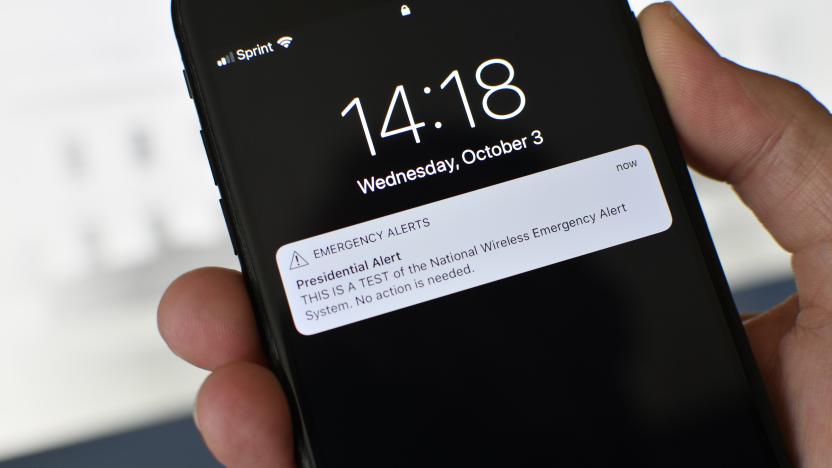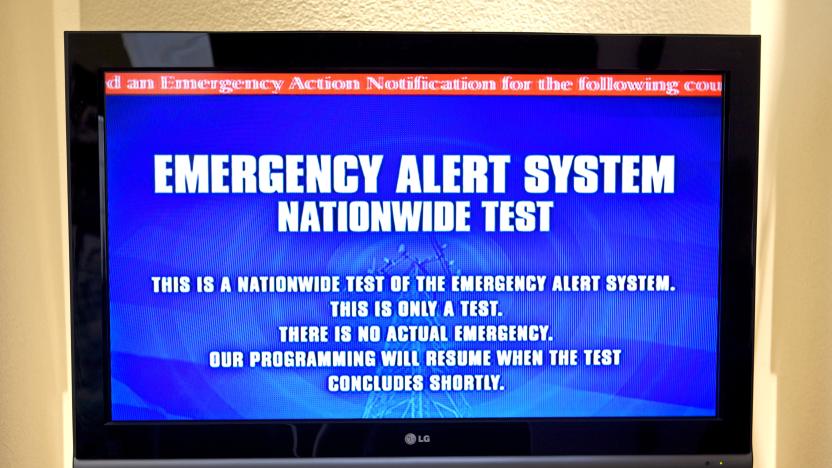emergency alert system
Latest

FCC proposes rules to prevent fake emergency alerts
The FCC has proposed rules that could limit false emergency alerts meant to create panic.

FCC aims to make emergency alerts more accessible for the hard of hearing
An FCC proposal would make the Emergency Alert System more accessible to people with hearing issues.

FEMA's next Emergency Alert System test leaves internet devices out
Federal agencies are once again poised to test emergency alerts, but this time it's all about where you won't see them. The FCC and FEMA are conducting their fifth nationwide Emergency Alert System test on August 7th at 2:20PM ET, but only on TV and radios. They want to gauge the preparedness of the alerting system when there's no internet access -- important if a crisis knocks out data but not power.

FEMA and National Weather Service launch Wireless Emergency Alert System
While it's a little later than expected, the free SMS emergency notification system has now gone live. Wireless Emergency Alert (WEA) messages will be delivered to cell towers in affected areas, which will then broadcast them to all compatible devices in their range. While the system is looking to cover over 97 percent of the country, it's being gradually rolled out across carriers. Sprint and Verizon are both apparently ready for action and while we haven't heard about the status of T-Mobile or AT&T, the National Weather Service has stated that hundreds of smaller carriers haven't yet enabled the broadcasts. However, not all phones -- especially the more elderly bricks still in circulation -- will work with the system. To check whether your weighty cellular still passes muster, hit up the compatible device list at the CTIA link below.

Wireless Emergency Alert system goes live this month, delivers location-based SMS warnings
Last we heard of the federal government's Wireless Emergency Alert system, only Sprint had signed on to deliver the SMS warnings. Now, with the secured participation of all four major carriers and smaller regional operators, that gratis service is set to go live this month, covering nearly 97 percent of active mobile users. Using a "point-to-multipoint system" that targets at-risk subscribers, the National Weather Service, FEMA, FCC and Department of Homeland Security-backed initiative works by sending location-based messages of 90 characters or less to nearby handsets in the event of an imminent meteorological threat. The mostly opt-out service will also accommodate AMBER and Presidential alerts, although you won't have that flexibility for missives sent from our head of state. So, the next time your phone gives off a strange auditory tone, you'll know to head for shelter.

Sprint plans Emergency Alert messaging system in New York City, claims this is only a test
Know those emergency alerts that always seem to crop up when your sports team of choice is about to score a crucial goal? Yeah, well they're headed to a Sprint phone near you, signature auditory tone and all. After successfully testing the service in San Diego last fall, the carrier's gearing up for round two of the FCC and Mayor Bloomberg-approved system in New York City later this year, issuing FEMA alerts from the President, National Weather Service and local emergency operators to over a dozen compliant Android phones. If you're sporting a compatible handset, you can opt-in for the service by either dialing ##CMAS## or selecting the appropriate settings prompt, after which you'll receive geographically-specific texts of up to 90 characters. And don't worry about dismissing these warning messages as any 'ol SMS or racking up additional fees, they'll arrive free-of-charge bearing a unique "vibration cadence" and inbox icon. Curious to see if your phone's made the cut? The skip on past the break for the official PR.

PSA: FEMA to test nationwide Emergency Alert System today, emphasis on 'test'
Don't freak out or anything, but at 2 PM EST today, the US government will sound a nationwide alarm. Barring a coincidence of cataclysmic proportion, however, it will only be a test. It's all part of FEMA and the FCC's Emergency Alert System (EAS), which is slated to be tried out on a nationwide level for the very first time. If, like us, you've spent a healthy portion of your life sitting in front of the TV, you're probably familiar with those monthly local alerts that tend to flash across the screen smack dab in the middle of a Saved by the Bell rerun. That's basically what's gonna happen today across the nation's television and radio networks. Some TV viewers will hear that familiar "this is a test" message during the trial, though most will simply see the word "test" run across their screens. The EAS would allow the president to disseminate information to the public in times of real emergency, which is why the government is so eager to make sure it actually works. All told, it'll last about 30 seconds, so plan your End of the World party accordingly. For more details, hit up the source links below.

PLAN emergency alert system going mobile in NYC and DC this year, nationwide in 2012
If you live in the U.S., you've probably seen those anger-inducing emergency alert system test messages that interrupt your favorite programming on a weekly basis. Most of us have never seen the system used in an actual emergency, but come later this year, cell phone users in New York and Washington will have similar alerts pushed to their mobile devices -- presumably without the annoying weekly tests. Known as PLAN (Personal Localized Alerting Network), the free service will reportedly only work with smartphones (we're guessing the GPS comes into play here) on AT&T&T, Sprint and Verizon. The secure messaging network will likely display messages as notifications, rather than texts, and will push to all compatible devices within an affected area based on the phone's physical location, not just its mobile number. Local, state and federal officials will send notifications in response to disasters and other public safety threats, presidential announcements, and Amber Alerts. In other words: it'll only be used for actual emergencies, so don't expect updates on the whereabouts of your favorite captive reptile.




